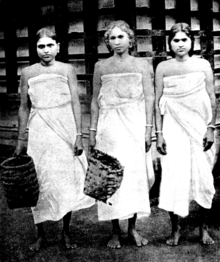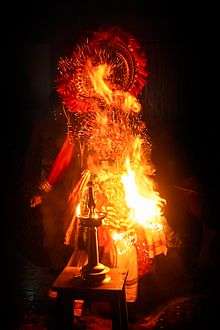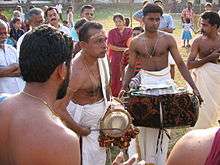Ambalavasi
Ambalavasi (Ampalavasi) is a generic name for a group of castes among Hindus in Kerala, India, who render temple services. Some Ambalavasi castes are patrilineal, while the others are matrilineal. Those that practise matrilineality share many cultural similarities with the Nair caste. Their ritual rank in Hinduism lies somewhere between the Brahmin castes and the Nairs.[1][2]
Castes

The Ambalavasis are broadly divided into two groups, being those who wear the sacred thread and those who do not.
Sacred thread wearers
Pushpaka Brahmins
Threadless Ambalavasis
- Pisharody[2]
- Marar,[2] who act as temple musicians
- Warrier[2]
- Poduval,[2] who works as temple watchman[7][8]
The feminine names of threadless ambalavasi castes are formed by adding the suffix -syar to the masculine names as Adi-Adisyar, Pisharadi-Pisharasyar, Marar-Marasyar, Variar-Varasyar, Poduval-Poduvalsyar.
Temple services
Though all Ampalavāsis have to do service in temples, they have sufficiently distinct functions to perform. Pushpakans and Nambeesans are teachers in the Pathasalas or Mutts and suppliers of flowers to temple. Chakyar stages drama. Marar serves as temple musician. Variar and Poduval did managerial and executive functions of temple committees and served as storekeepers [9]
Kazhakams
Kazhakams or Ambalakkazhakams refer to associations of ambalavasi peoples in a temple to perform specific duties in the temple.[10]
Temple arts


Sri. Chendamangalam Unnikrishna Maarar in action - In the middle.
Traditionally, Ambalavasis are associated with various types of temple arts. Earlier, each of these temple arts were performed only by specific Ambalavasi castes. Now there is no community or caste barrier.
| Temple Art | Associated Ambalavasi castes |
|---|---|
| Koodiyattam | Chakyar[11], Pushpakan Unni |
| Kooth | Chakyar,[12] Nangyar (women of Nambiar)[13] |
| Certain roles of Krishnanattam | Nambeesan or Pushpaka Unni[14] |
| Mizhavu (Musical Instruemnt) | Nambiar[15] |
| Kuzhithalam (Musical Instruemnt) | Nangyar (women of Nambiar) |
| Thullal | Nambiar |
| Theeyattu | Theeyatt Unni, Thiyyadi Nambiar |
| Pathakam | Nambiar[16] |
| Vadyams (Musical Instruments) like Chenda, Idakka, Udukku etc. | Marar |
| Panchavadyam | Marar |
| Sopanasangeetham | Marar, Pothuval |
| Brahmanippattu | Brahmani (women of Nambeesan)[17][18] |
Temple types
They lived in villages either where the land was owned solely by one Nambudiri Brahmin family or where the land was owned by a temple, the running of which was in the control of a group of Nambudiri families. The latter villages were called sanketams.[2]
The temples in which they worked comprised four basic types:[2]
- Those in sanketams were large and were dedicated to deities which were worshipped throughout India, such as Shiva and Vishnu.
- Private temples, owned by Nambudiri families, which were the smaller versions of those found in the sanketams.
- The private temples of the royal lines, feudatory chiefs and vassal chiefs of what is now Kerala, which were dedicated to Bhagavati (Bhadrakali)
See also
References
- Fuller, Christopher J. (1976). The Nayars Today. Cambridge University Press. p. 13. ISBN 978-0-52129-091-3.
- Gough, Kathleen (1961). "Nayars: Central Kerala". In Schneider, David Murray; Gough, Kathleen (eds.). Matrilineal Kinship. University of California Press. pp. 309–311. ISBN 978-0-520-02529-5.
- Report on the Socio-economic Survey on Castes/communities, Kerala 1968. Bureau of Economics & Statistics, Government of Kerala. 1969. p. 42.
- Report of the Commission for Reservation of Seats in Educational Institutions, Kerala, 1965. Kerala: Commission for Reservation of Seats in Educational Institutions, Kerala, India. 1966. p. 140.
- Temple, Richard Carnac (1908). The Indian Antiquary Vol-xxxvii. Brotrtu, London: British India Press. pp. 335–337.
- Daugherty, Diane (1996). "The Nangyār: Female Ritual Specialist of Kerala". Asian Theatre Journal. Vol. 13, No. 1 (Spring, 1996 (1): 54–67. doi:10.2307/1124302. JSTOR 1124302.
- People of India - India's Communities N-Z. Oxford University Press. 1998. pp. 2861–2863.
- Census of India 1911. Vol. 23, Travancore. Pt. 2, Imperial tables. 1912. p. 53.
- Madhavan, K.S. "INTERNALIST PERCEPTION OF "JATI" — A STUDY OF BRAHMANICAL CANONICAL LITERATURE IN KERALA". Proceedings of the Indian History Congress. Vol. 62 (2001): 84–97.
- People of India - India's Communities N-Z. Oxford University Press. 1998. pp. 3605–3607.
- Narayanan, Mundoli (2006). "Over-Ritualization of Performance: Western Discourses on Kutiyattam". TDR. 50 (2): 136–153. doi:10.1162/dram.2006.50.2.136. JSTOR 4492680.
- "Latest India News | Breaking News | World & Business News | Sports & Entertainment news". Expressbuzz.com. Retrieved 30 September 2013.
- "The 'Florance' of Nangiar Koothu" (10 September 2015). Mathurubhumi Daily. 10 September 2015. Retrieved 17 February 2019. Quote: Nangyarkoothu is a traditional artform performed by the women of the Ambalavasi Nambiar community of Kerala, called Nangyaramma. However, people from other castes also has been performing the artform since the second half of the 20th century.
- Sikora, Martha Bush (1993). Krishnanattam. Oxford & IBH Publishing Company.
- Dutta, Madhumita (2008). Let's Know Music and Musical Instruments of India. Star Publications. p. 16.
- "Padakam, the poor cousin of Chakyarkoothu - Times of India". The Times of India. Retrieved 16 January 2018.
- Nampoothiri, M.V. Vishnu (2012). Folklore: The Identity of Culture. Department of Information & Public Relations, Government of Kerala. p. 73.
- V.T., Induchudan (1969). The Secret Chamber: A Historical, Anthropological & Philosophical Study of the Kodungallur Temple. Cochin Devaswom Board. p. 260.